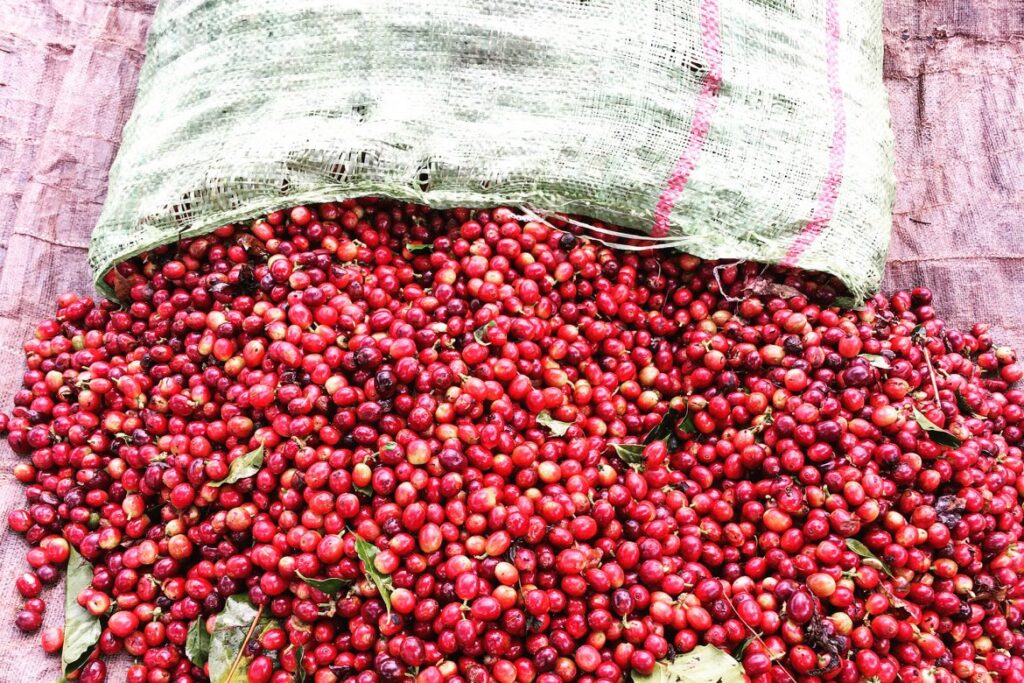Although it is the world’s second-largest coffee producer, Vietnam has never had a reputation for producing high-quality Arabica. Robusta accounts for the majority of beans grown in the country, meaning that the likeliest place you’ve experienced Vietnamese coffee is in espresso blends—where it’s added for crema-improving qualities—or as instant, freeze-dried powder.
This year, three domestic producers are hoping to change that. Tran Nhat Quang from La Viet Coffee, Nguyen Dung from The Workshop, and Nguyen Canh Hung from Bosgaurus Coffee share a mutual vision of bringing Vietnamese Arabica’s overall quality up to specialty standards. By innovating growing and processing practices in Vietnam’s central highlands, they hope to develop a high-quality coffee production model that can scale.
The three chose to hone in on a single varietal for improvement—Catimor. Catimor, often typecast by the specialty coffee industry for its characteristics inherited from Robusta, is nonetheless widely planted in Vietnam due to its high yield and leaf rust resistance. Its quality improvement could, as a result, have a major impact on the country’s overall coffee quality, and affect a greater number of producers than that of any other varietal.
The First Brick In The Wall

Broad changes to industry take time and effort. This year, the three producers focused on improving the cup quality from a single farm—owned and operated by Pham Manh Hung. They helped Pham implement harvesting and processing best practices across his five-hectare land area (about the size of seven soccer fields), which has a production capacity of 10 tons of Catimor per year.
Pham’s farm is located at 1,450 meters above sea level, in the Lam Dong region’s Cau Dat area—Lam Dong is where the majority of Arabica is cultivated in Vietnam, with varietals overwhelmingly constituted of Red and Yellow Catimor. Prior to this year, Pham had been planting commodity-grade coffee for 10 years. He decided to collaborate with La Viet, The Workshop, and Bosgaurus to raise his coffee quality to specialty standards.
They began with the harvest.
Because strip harvesting is the norm in Vietnam, it is vital to provide producers with skills in selective picking. Wages for harvesting are typically paid by weight of picked cherry—to increase quality, that metric has to be shifted to cherry quality.
“Old habits die hard,” Bosgaurus Coffee owner Nguyen Canh Hung says of the implementation of quality-focused picking on Pham’s farm. “Although we paid pickers higher wages than the market standard, close monitoring and incentives to reward pickers were needed to improve quality. We gradually increased the percentage of ripe cherries picked, achieving 99% by the end of the harvest.”
Trust The Processing

For the owners of Bosgaurus, La Viet, and The Workshop, acquiring ripe cherries was just the first step in a longer journey to scale specialty grade coffee in Vietnam. The next step was applying innovative processing methods. Generally, processing is overlooked by the country’s coffee industry, and in fact is regarded as a potential risk to quality rather than a tool with which to improve it. The industry’s assumption as a whole is that the longer a coffee’s processing time, the higher the risk of beans being subject to unexpected weather changes. Bosgaurus’ Nguyen believes that changing this mindset is crucial, and that processing could become a positive agent of increasing quality if he can reduce its variability.
The three producers started by experimenting with a processing method borrowed from wine production called yeast fermentation. They bought yeasts from Fermentis—a company specializing in producing yeasts for beer and wine processing. Yeasts were hydrated and injected into fermentation tanks along with coffee seeds for different durations, between 22 and 72 hours. Every two hours during the fermentation process, data on moisture content, humidity, temperature, water quality, pH, and degrees Brix were measured and recorded.
After, washed beans were dried on raised beds for 20 days. Typically, Vietnamese Catimor tends to have a sharp acidity, with a woody and nutty flavor. Coffee from one recent batch of 72-hour yeast-processed Catimor prepared with a Hario V60, however, dazzled with a bright and fruity acidity more akin to Kenyan coffees—the mouthfeel was juicy and the aftertaste sweet. And although this particular brew had some of the varietal’s signature woody flavor, once cooled, the cup’s overall complexity was remarkable.
“For now, the exact effect of yeasts on coffee flavor remains to be seen,” Bosgaurus’ Nguyen says. “As this is a novel approach to coffee processing, we cannot say for sure which yeast strain will contribute which flavor to the coffee.”

He went on to explain that through a relationship with Lucia Solis, a prominent coffee fermentation designer currently experimenting with yeast fermentation processing in countries across South America, he was developing specific processing techniques to bring sweetness to Catimor’s flavor profile. They’re also finding that longer fermentation times appear to lend more complexity and higher cupping scores to coffees.
The quality specialists in Vietnam are also experimenting with a method of juice fermentation, which entails flushing fermentation tanks with water, yeast, and fresh, concentrated pineapple juice for a period of 36 hours. The juice provides nutrition for the yeasts, accelerating their microbial activity to add fruitier flavors to coffee. The end result of one juice fermentation trial was a sample aptly named “Pineapple,” whose cups had an aroma of tropical fruit, a citrus-like acidity, a hint of orange sweetness, tea-like body, and a chocolatey finish.

